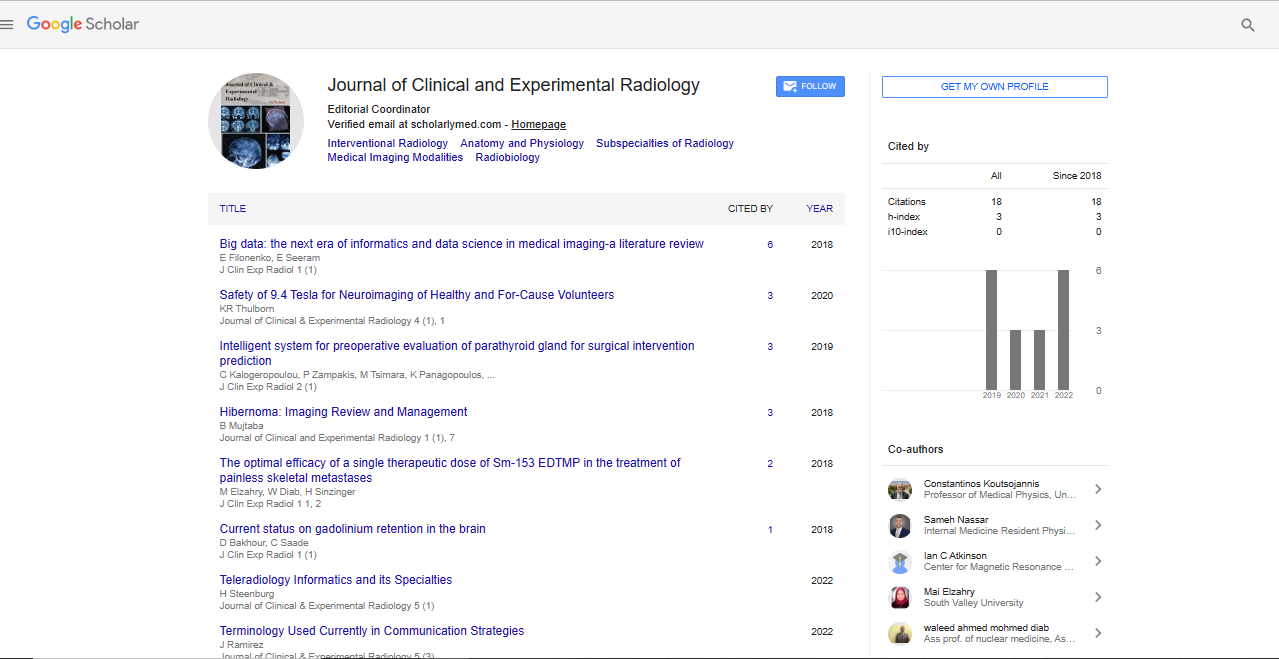Opinion Article, J Clin Exp Radiol Vol: 6 Issue: 4
Radiation Oncology: Navigating the Complexities of Tumor Irradiation
Studenski V Laachaniv*
1 Department of Radiation Oncology, University of Miami, Miami Floria, USA
*Corresponding Author: Studenski V Laachaniv,
Department of Radiation Oncology, University of Miami,
Miami Floria, USA
E-mail: laachaniv07@gamil.com
Received date: 24 November, 2023, Manuscript No. JCER-24-128616;
Editor assigned date: 28 November, 2023, PreQC No. JCER-24-128616 (PQ);
Reviewed date: 14 December, 2023, QC No. JCER-24-128616;
Revised date: 21 December, 2023, Manuscript No. JCER-24-128616 (R);
Published date: 28 December, 2023, DOI: 10.4172/jcer.1000158
Citation: Laachaniv SV (2023) Radiation Oncology: Navigating the Complexities of Tumor Irradiation. J Clin Exp Radiol 6:4.
Description
Radiation oncology stands at the forefront of cancer treatment, offering a powerful tool in the fight against malignancies. Among the diverse modalities available, tumor irradiation holds a central role in the therapeutic armamentarium. Its efficacy is rooted in the ability to precisely target cancer cells while sparing healthy tissues, yet the journey through radiation therapy is far from straightforward. This essay explores the multifaceted landscape of radiation oncology, delving into the complexities of tumor irradiation, from its historical origins to modern innovations and challenges. The origins of radiation therapy can be traced back to the late 19th century when pioneers like Wilhelm Conrad Roentgen discovered the properties of X-rays. This breakthrough laid the foundation for the use of ionizing radiation in medical applications. Early experiments revealed the potential of radiation to shrink tumors, albeit with crude techniques and limited understanding of its biological effects. Over the ensuing decades, advancements in technology and radiobiology fueled the evolution of radiation oncology into a sophisticated discipline.
At its core, tumor irradiation relies on the principle of selectively damaging cancer cells while minimizing harm to surrounding healthy tissues. This dichotomy is achieved through precise targeting and dose optimization, facilitated by a myriad of techniques such as Intensity- Modulated Radiation Therapy (IMRT), Stereotactic Body Radiation Therapy (SBRT), and proton therapy. Each modality offers unique advantages and challenges, underscoring the importance of personalized treatment planning tailored to the individual patient and tumor characteristics. Beyond the province of physics and technology, the efficacy of tumor irradiation hinges on an intricate interplay of biological processes. Radiation-induced DNA damage triggers a cascade of molecular events, including cell cycle arrest, apoptosis, and DNA repair mechanisms. The tumor microenvironment further modulates radiation response, with factors such as hypoxia, angiogenesis, and immune infiltration influencing treatment outcomes. Understanding these complex interactions is essential for optimizing radiation therapy regimens and overcoming mechanisms of resistance.
Radiation oncology encompasses a diverse array of clinical applications across various cancer types, ranging from curative intent treatments for localized disease to palliative care for advanced malignancies. Recent years have witnessed remarkable innovations in the field, driven by advancements in imaging, computational modeling, and radiation delivery technology. Image-Guided Radiation Therapy (IGRT) allows for real-time tumor tracking and adaptive treatment strategies, enhancing precision and minimizing toxicity. Furthermore, the integration of molecular targeted agents and immunotherapy with radiation holds promise for synergistic therapeutic approaches.
Despite its efficacy, radiation therapy is not without limitations and challenges. Acute and late toxicities remain a concern, particularly in organs at risk and with prolonged treatment courses. Tumor heterogeneity and clonal evolution pose challenges for achieving durable responses, necessitating strategies to overcome radio resistance and enhance treatment efficacy. Additionally, disparities in access to radiation therapy highlight the need for equitable distribution of resources and infrastructure globally. Looking ahead, emerging technologies such as radionics, artificial intelligence, and particle therapy offer exciting prospects for further enhancing the precision and effectiveness of tumor irradiation.
Conclusion
Radiation oncology represents a dynamic and evolving field, continually pushing the boundaries of science and technology in the pursuit of improved cancer care. Tumor irradiation, with its complexities and nuances, stands as a cornerstone of modern oncology, offering hope and healing to countless patients worldwide. As we navigate the intricacies of radiation therapy, from bench to bedside, let us remain steadfast in our commitment to advancing the science, refining our techniques, and ultimately, delivering the best possible outcomes for those battling cancer.
 Spanish
Spanish  Chinese
Chinese  Russian
Russian  German
German  French
French  Japanese
Japanese  Portuguese
Portuguese  Hindi
Hindi 